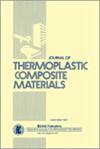The effect of physical compatibilization and dynamic vulcanization on the properties of thermoplastic vulcanizates derived from polypropylene and natural rubber blends
IF 3.6
4区 材料科学
Q2 MATERIALS SCIENCE, COMPOSITES
引用次数: 0
Abstract
This interesting study investigated the effect of Maleic Anhydride-grafted-Polypropylene/Epoxidized Natural Rubber (PP-g-MA/ENR) as a compatibilizing agent (CA) on the properties of a 30/70 Polypropylene/Natural Rubber PP/NR blends. The effect of dynamic vulcanization with sulfur-donors (i.e.: Tetramethyl thiuram disulfide (TMTD) and 4,4 Dithiodimorpholine (DTDM)) which were used as vulcanizing agents was also reported. Several formulations of TPVs with different concentrations of CA (from 5 to 15 phr) were prepared by mixing in the molten state using a Haake Rheocord 90. The structural analysis of dual compatibilizer was examined by FTIR spectroscopy. The rheological behavior was examined using Haake Rheocord 90. The mechanical properties were determined by the tensile measurements. The dynamic mechanical thermal properties were investigated by DMA. A morphological examination was conducted using SEM Microscopy, respectively. FTIR analysis confirmed reactions between the MA group in PP-g-MA and the epoxy groups in ENR, resulting in ENR-grafted PP with an ester and acid-based linkage. The Haake plastograms revealed a proportional increase in the final mixing torque value with the increasing content of CA. The mechanical results exhibited higher values in terms of tensile strength and Young’s modulus for the TPVs containing CA compared to un-compatibilized ones. The compatibilized TPV blends exhibited a noteworthy increase in storage modulus and a notable decrease in loss tangent values with the CA concentration increased. Furthermore, the TPVs show two distinct-phase morphologies. That is, the TPV with CA showed the presence of smaller vulcanized rubber particles dispersed within the PP matrix, a phenomenon that becomes more pronounced with higher CA contents.物理相容和动态硫化对聚丙烯和天然橡胶混合物热塑性硫化弹性体性能的影响
这项有趣的研究调查了马来酸酐接枝聚丙烯/环氧天然橡胶(PP-g-MA/ENR)作为相容剂(CA)对 30/70 聚丙烯/天然橡胶 PP/NR 混合物性能的影响。此外,还报告了使用硫代剂(即:二硫化四甲基秋兰姆(TMTD)和 4,4-二硫代二吗啉(DTDM))进行动态硫化的效果。通过使用 Haake Rheocord 90 在熔融状态下进行混合,制备了几种含有不同浓度 CA(从 5 到 15 phr)的热塑性硫化弹性体配方。通过傅立叶变换红外光谱分析了双相容剂的结构。使用 Haake Rheocord 90 对流变行为进行了检测。拉伸测量确定了机械性能。用 DMA 研究了动态机械热性能。分别使用 SEM 显微镜进行了形态检查。傅立叶变换红外光谱分析证实,PP-g-MA 中的 MA 基团与 ENR 中的环氧基团发生了反应,生成了具有酯基和酸基连接的 ENR 接枝 PP。哈克塑形图显示,随着 CA 含量的增加,最终混合扭矩值也成比例增加。力学结果显示,与未相容的热塑性硫化弹性体相比,含有 CA 的热塑性硫化弹性体的拉伸强度和杨氏模量值更高。随着 CA 浓度的增加,相容热塑性硫化弹性体混合物的储存模量显著增加,损失正切值明显下降。此外,热塑性硫化弹性体呈现出两种不同的相态。也就是说,含有 CA 的热塑性硫化弹性体显示出较小的硫化橡胶颗粒分散在聚丙烯基体中,CA 含量越高,这种现象越明显。
本文章由计算机程序翻译,如有差异,请以英文原文为准。
求助全文
约1分钟内获得全文
求助全文
来源期刊

Journal of Thermoplastic Composite Materials
工程技术-材料科学:复合
CiteScore
8.00
自引率
18.20%
发文量
104
审稿时长
5.9 months
期刊介绍:
The Journal of Thermoplastic Composite Materials is a fully peer-reviewed international journal that publishes original research and review articles on polymers, nanocomposites, and particulate-, discontinuous-, and continuous-fiber-reinforced materials in the areas of processing, materials science, mechanics, durability, design, non destructive evaluation and manufacturing science. This journal is a member of the Committee on Publication Ethics (COPE).
 求助内容:
求助内容: 应助结果提醒方式:
应助结果提醒方式:


